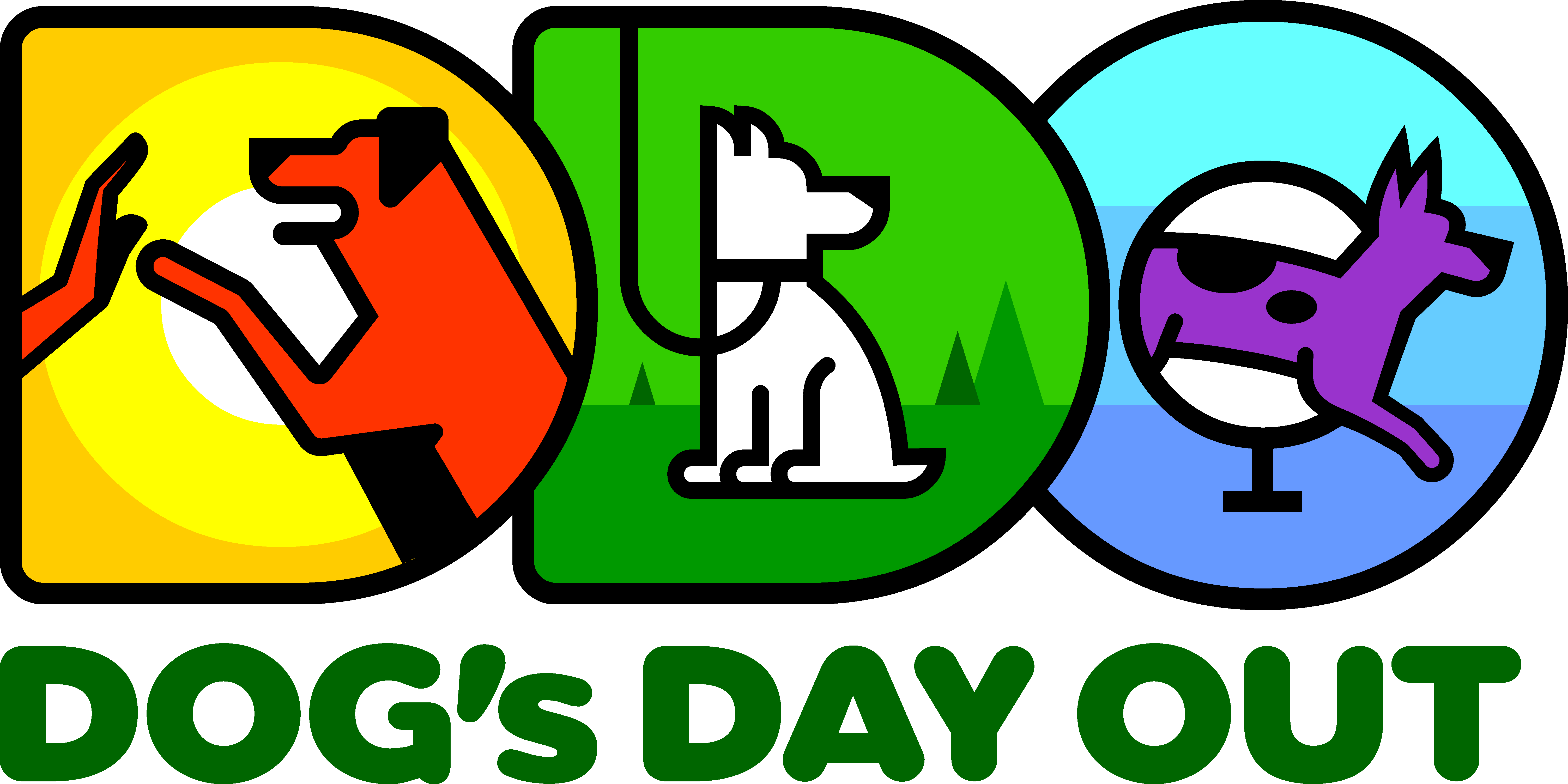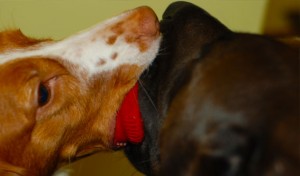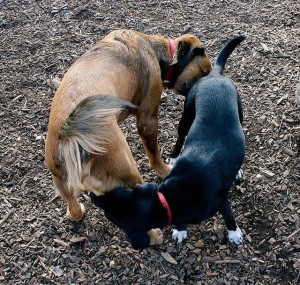How do you know when your dog is playing well with others and having a good time?
Owning a dog day care, I have seen a lot of dogs playing together. Sometimes the play is great and sometimes well, not so great. How can you tell if your dog is truly having a good time or if his “playtime” could be causing more harm than good? In general, unless a dog has had a traumatic life event, they are fun machines and love to play!
When monitoring dog play there are a few things to keep in mind…
Your dog may change his mind about who he wants to play with.
As a puppy (if safely socialized) most pups will play with anyone but as they get older their play preferences can (and usually do) change. We usually see preference and tolerance changes at the onset of adolescence (about 7-9 months) and then again at the onset of maturity (about 1.5 – 2.5 years). As dogs age, they tend to get a bit more particular about their friends. Not unlike most humans really – kids will pretty much play with anyone but as adults, unless you are a true social butterfly, you are probably more particular about the company you choose to hang out with as well. Just because your dog would play with everyone as a young dog, it does not mean he will always want to.
Play styles vary.
While there are no scientific studies currently that conclude dogs have specific “play styles,” some dogs certainly prefer to wrestle and some prefer to chase. Figure out what type of play your dog enjoys most. A rough-and-tumble boxer or pittie type may be obnoxious (and offensive) to a herder. Some dogs, who have played with many different types of dogs and had positive experiences doing so, are good at tailoring their play for the dog they are playing with but some are lousy at that. If it’s a bad match, someone will end up not having a good time.
Frustration and Arousal.
When dogs play, two factors that must be present for it to be play are frustration and arousal – those factors make play FUN. They are also components for a dog fight. From a scale of 1-5, if a sleeping dog is at a level 1 and a dog fight is a level 5, play is somewhere in between (2-4). It is important to be able to “read” your dog’s arousal and frustration level so that you can keep the levels below 5 (fight!). Level 2-3 is great but when I see things going up to a 4, I want to diffuse the play. I’ll get to diffusing the situation later.
Body Language.
It is imperative for you to be able to “read” your dog’s body language and know when your dog is happy, aroused, stressed or afraid. Before you can know if your dog is playing well, you need to know exactly what he looks like when he is feeling certain ways. If you can tell that your dog is getting overly aroused, stressed or tired, you can pull him from play and prevent any escalating undesired behaviors.
What are components of good (safe and fun) play?
- Circular greetings and movements. Dogs can be considered rude by others if they charge straight at them and can get in trouble because of it. In a polite greeting, dogs come at each other at a bit of an arc, may sniff noses briefly, and then circle each other nose to tail. A mutual butt sniff is a polite how-do-you-do.
- Good play should have pauses and may look like: wrestle/chase, stop and sniff the ground/bushes, wrestle/chase, possible body shake (like he just had a bath), go pee, wrestle/chase, go sniff something and on and on. Some dogs are better at pausing themselves in play than others. If you have a dog who is not so good at pausing, you need to put the pauses in for him by redirecting him periodically. You may do this by calling him over in a happy voice, squeaking a squeaky toy or giving him a treat and then letting him go back to play. Always make your interruptions happy and fun; you are not punishing your dog, you are just trying to keep his arousal at a safe level. You may have to get creative in how you get his attention in the middle of play – generally, I look for the slightest of breaks from either of the dogs so I can get them to pause. This is also a great way to work on your recall.
- Playful Body Language. Some of these include:
- Play Bows – butt up, elbows touching the ground (all the way!) is a way for your dog to solicit another dog to play and to tell him he’s all fun and here for a good time.
- Open mouths.
- Exaggerated lateral movements.
- Loose and bouncy bodies, horsey moves.
- Tails low or level with body and with loose wags.
- Curved spines.
- Running parallel (along side) each other.
- Self-handicapping – a dog who is obviously bigger/stronger easing his play so that he can play with another dog. Maybe a big dog laying down to play tug with a small dog or puppy. This also includes:
- Bite inhibition when a dog inhibits his bite force to play with his mouth. This is an extremely important skill a dog must have to play with others. They learn this at a very young age by playing with other puppies. Learning bite inhibition is one of the most important skills for a puppy to learn and why it is so important to get your puppy into a safe, well-run puppy group/class as soon as you can.
What are the problem behaviors in play?
- Little or no pausing.
- Increasing arousal.
- Tail high and wagging quickly – this is not generally a “happy” tail, rather a sign of arousal.
- Little or no self-handicapping.
- One dog trying to terminate play and the other dog continuing to pursue.
- Ongoing vertical play – I do not like to see dogs “playing” on their hind legs for more than brief moments. More lateral play is what we want to see.
- Raised hackles (piloerection). Hackles refer to the line of fur that runs the length of a dog’s back. Simply put, hackles are an involuntary arousal response. It can be normal for a dog’s hackles to raise when in a new situation or meeting new dogs but I do not like to see them remain raised in play. Some folks may disagree with me on raised hackles in play because they have dogs, or know dogs, that play together with hackles raised and have not had a problem and I’m sure that is true. To me though, hackles are simply information about the dog’s emotional state in a given moment and when they are raised they tell me the dog is already at certain level of arousal. I guess I like to play it safe. When a dog first enters a situation with other dogs I am not too concerned if his hackles are raised but I want to see them to go back down within about a minute (time varies between dogs) and be down before play commences.
Lastly, not all dogs do well playing in a group of dogs (dog park or day care) but most are able to have select play mates to interact with, even if it is just to walk together. In either case, it is important to understand and facilitate safe, appropriate and fun play. See How to Introduce Dogs for more information on having a successful first meeting with a potential dog playmate.


